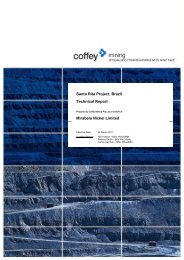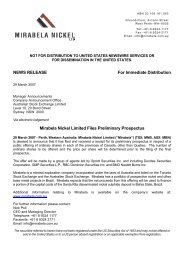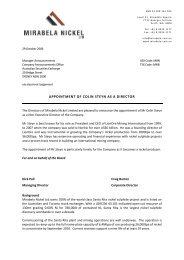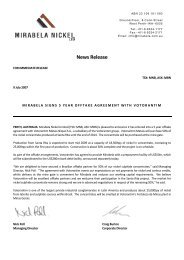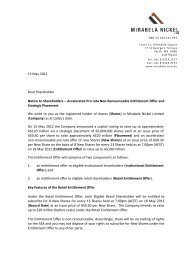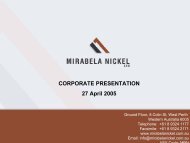COPY OF FINAL PROSPECTUS - Mirabela Nickel
COPY OF FINAL PROSPECTUS - Mirabela Nickel
COPY OF FINAL PROSPECTUS - Mirabela Nickel
You also want an ePaper? Increase the reach of your titles
YUMPU automatically turns print PDFs into web optimized ePapers that Google loves.
sample of approximately two kilograms was collected for submission to the laboratory for analysis. In drill-holes<br />
of interest, the final samples were one metre intervals, however for the majority of the sterilisation program the<br />
samples were four metre composites. The sampling represents industry standard practices. In wet holes, the<br />
samples were left to dry as best possible, and then homogenized and quartered by hand. RC chip trays were<br />
systematically logged by collecting the sieved RC chips and storing them in a tray, with each labelled<br />
compartment of the tray containing the chips from one metre. RC sampling has not been reviewed by<br />
RSG Global.<br />
RSG Global concluded that the sampling procedures for diamond drilling are consistent with current<br />
industry best practices. RSG Global did not assess the RC drill quality however RSG Global did conclude that<br />
the approach used by <strong>Mirabela</strong> is consistent with current industry best practice, except for wet drilling. The RC<br />
drilling has not been used to generate the mineral resource in the Technical Report.<br />
Sample Security and Analysis<br />
Current <strong>Mirabela</strong> drilling procedures require samples to be taped closed once taken from the core sampling<br />
facility. Samples are then transported directly to the laboratory. Reference material is retained and stored on<br />
site, including half-core and photographs generated by diamond drilling, and duplicate pulps and residues of all<br />
submitted samples. All pulps are stored at ALS Chemex’s storage facility in Belo Horizonte.<br />
<strong>Mirabela</strong> uses ALS Chemex Ltd. as its principal analytical laboratory. Sample preparation is completed in<br />
Brazil and the analytical laboratories in Perth, Australia, and Vancouver, Canada, assay the pulps. Umpire assay<br />
checks in respect of Santa Rita were completed by ACME Analytical Laboratory Ltd. in Vancouver, Canada,<br />
and Ultra Trace Analytical Laboratories, in Perth, Australia.<br />
RSG Global concluded that the analytical methods, sampling methods, chain of custody procedures, sample<br />
preparation procedures and analytical techniques are appropriate and compatible with accepted industry<br />
standards.<br />
The current quality control procedure at Santa Rita consists of four quality control samples: blanks,<br />
certified reference material (standards), coarse reject sample duplicates (at the lab) and pulp re-assay (umpire<br />
lab checks).<br />
With the exception of Au, the assaying reviewed by RSG Global in respect of Santa Rita deposits was<br />
considered both accurate and precise and suitable for mine planning studies. RSG Global completed a<br />
comparative analysis of the quality control protocols and concluded that they were of high industry standard and<br />
should be maintained for future drilling programs.<br />
Bulk density determinations have also been carried out by <strong>Mirabela</strong>. Density data (3,327 determinations for<br />
Santa Rita) has been collected by <strong>Mirabela</strong> using billets selected from available diamond core. The methods<br />
applied to density collection for Santa Rita included sun drying, weighing the core in air and weighing water.<br />
The bulk density was then determined as a ratio of weight in air over weight in water. The weighing is completed<br />
using high quality electronic scales with regular calibration of the scales completed. RSG Global confirmed that<br />
this method represents an industry standard approach to dry bulk density collection when no porosity is present<br />
in the rocks, as is the case for the sulphide/fresh mineralization.<br />
Mineral Resources and Mineral Reserves<br />
Mineral resource estimates were prepared by Brett Gossage of RSG Global in accordance with NI 43-101,<br />
the Canadian Institute of Mining, Metallurgy and Petroleum Standards on Mineral Resources and Reserves and<br />
the Australasian Code for Reporting of Mineral Resources and Ore Reserves 2004 Edition (the ‘‘JORC Code’’).<br />
Mr. Gossage is a Competent Person as defined by the JORC Code and a Qualified Person for the purpose of<br />
NI 43-101 and is independent of the Company.<br />
33




